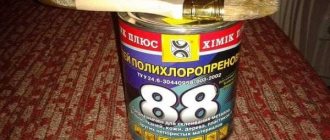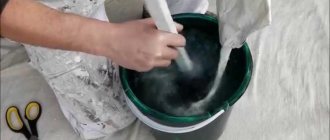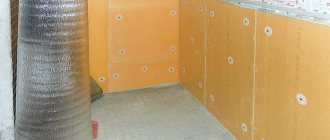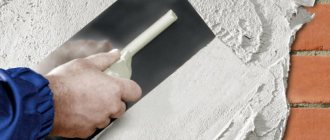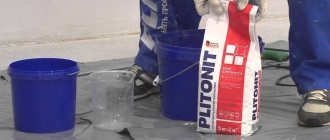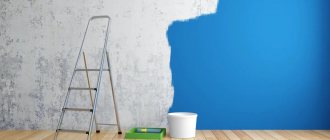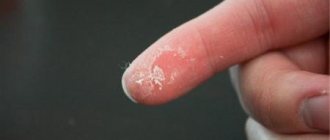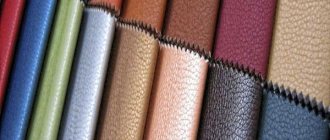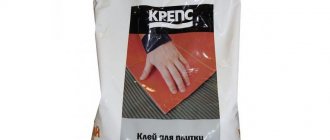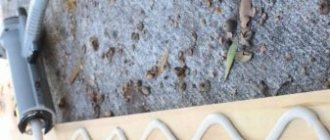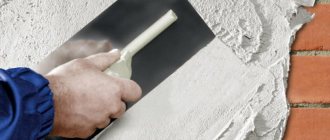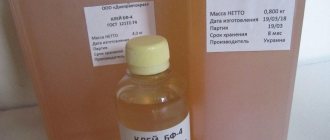From Sheetrock to Danogips
The Danogips brand belongs to the Danogips company. In Germany, everyone knows this brand of construction and finishing products, but on the domestic market this name is a new product. The manufacturer produces dry and ready-made mixtures, primers, and gypsum boards. The quality of the goods is very good, and the prices are quite economical.
Ready-made Sheetrock putties also belong to the Danogips brand; they have gone through a design change with updated packaging. In the CIS countries, up to 1/3 of the entire market of ready-made wall putties is occupied by Shitrok. Now on sale there is a line of three products bearing the name of the umbrella brand Danogips, but retaining the composition and properties of Sheetrock.
Features of the material
Putties are suitable for all occasions, therefore they are considered universal. Their main purpose is to level walls made of concrete, plasterboard, brick before finishing, painting, or wallpapering. The description of the material states that it has high ductility. Indeed, the polymer finishing putty Shitrok has a number of advantageous features. They are due to their unique composition, which includes:
- finely ground limestone;
- fine fraction dolomite;
- ethylene-vinyl or acetate-vinyl copolymer;
- pyrophyllite and attapulgite.
The last mentioned materials give a dry sliding effect. This makes it easy to putty the walls on a dry surface. Of course, the composition also contains other components - substances that prevent the mixture from separating, preservatives, thickeners, stabilizers. Also, a special cellulose microfiber is used to add airiness to the mass. Due to its presence, the product becomes like whipped cream. The same component ensures high strength of the layer after puttying. Polyhydric alcohol is added to the composition, which prevents fungus and mold from multiplying.
The features of the material are:
- attaches well to the wall;
- does not fall off the spatula;
- perfectly smooth after drying;
- beautiful white or cream color;
- the mass dries quickly;
- The material is moisture resistant, but quite breathable.
In addition to puttying plasterboard or other surfaces, the material is also suitable for other purposes. Shitrok is suitable for removing cracks and defects on walls made of concrete, brick, and plaster. You can use putty to seal any seam between sheets of drywall on walls, ceilings and partitions, and apply connecting tape on top. Using Shitrok, corners are processed and metal surfaces are finished. With Shitrok you can create a beautiful decorative surface with a certain relief.
Types of plaster
Putty is produced in three types, each of which has its own characteristics of use.
- Taping Joint Compound. Used for restoration of damaged surfaces. Suitable for sealing cracks, has excellent adhesion to drywall. It is applied in the thinnest layer, but has high strength. The material has the lowest shrinkage characteristics. Often used for secondary application on walls. Putty is not suitable for processing seams.
- Sheetrock All purpose Compound. Universal putty, ideal for finishing walls, treating cracks and seams. It makes it easy to create texture and patterns on the surface. The material is not suitable for use in rooms with high humidity levels.
- Superfinish Danogips Sheetrock. A finishing putty with high adhesion, which, however, is not enough to treat large cracks. It is used for finishing drywall, painted surfaces, and fiberglass.
Material characteristics
The technical characteristics of the material allow it to maintain leadership in the market of similar products. Here are its main parameters:
- drying time - 3–5 hours;
- methods of working with mass - manual, mechanized;
- temperature of application of the material - from +13 degrees;
- density - 1.65 kg/l;
- packaging volume - sold in buckets of 3.5–17 liters.
The high density of the product can be intimidating, because the more dense it is, the more difficult it is to grind the material. But this does not apply to the Shitrock brand. Sanding the dried putty mass is very simple; a mesh with a grain size of 180 units is used for this purpose.
Safety precautions
When working with plaster, the following precautions must be taken:
- if the solution gets into the eyes, wash them with plenty of running water;
- during the grinding process, wear safety glasses, a respirator and gloves;
- the material is stored out of the reach of children;
- If accidentally swallowed, induce vomiting, rinse the stomach, or seek medical attention.
Consumption: Approximately 1 kg of Shitrok putty is used for 1 m2. This is explained by the fact that after drying the material does not “shrink”. The oily structure also reduces consumption, ensuring smooth gliding over the surface. Consumption of Sheetrock putty for processing drywall joints is 28 kg/55 m2, for texture – 28 kg/20 m2.
Advantages and disadvantages
What is better, Shitrok putty or other mixtures? This product has a huge number of advantages that distinguish it from its analogues:
- There is no need to mix the product; it is sold in finished form. After opening, you can immediately start working, which will save time and effort.
- The material is universal, it is suitable for leveling walls and finishing. You won't have to buy another finishing product.
- The product has a unique texture. The oiliness, smoothness, and plasticity of the putty allows it to adhere perfectly to the spatula and the wall. This makes the job much easier for a beginner. Ease of use is due to the ease of rubbing and puttying the layer.
- The fairly low consumption per 1 m2 of putty makes it attractive for those who value calculation and are trying to save money without sacrificing quality. The savings are also due to the thin layer thickness; there is no need for a thick coating.
- The material is sold in containers of different sizes; you can choose the one you need for each individual case.
- After drying, the surface will be very beautiful, smooth, pleasant to the touch, and primer can be easily applied to it. The material does not shrink; the manufacturer guarantees a minimum of 5 years without even small cracks.
- Shitrok will completely replace the primer. To do this, you just need to dilute it with water to a liquid consistency, then use it as a standard primer. Shitrok is also compatible with any brands of other construction and finishing materials.
- The shelf life of the package after opening is several months. If you close the lid tightly and place the material away from heat sources, storage for a year is allowed. By the way, it can be frozen; for further use, you need to defrost it at room temperature.
Shitrock doesn't have many downsides. After application to the wall, the shade of the material becomes not white, but light beige. This may negatively affect the color of the walls, which are planned to be painted white. Also, the disadvantages include the need for thorough preparation of the surface - it must be cleaned, degreased, and leveled in the presence of rough irregularities and defects. If this is not done, the adhesion of Sheetrock to the base will decrease.
Features of Shitrok plaster
The material has a number of positive characteristics, thanks to which it is popular. Among them are the following:
does not require kneading. The mixture is sold ready-made; just open the packaging and get to work. This significantly saves labor costs and time;- suitable for roughing and finishing surfaces;
- oily structure ensures ease of application, adheres to hand tools, does not drip;
- low material consumption is due to technical features, namely excellent density, due to which the layer comes out smooth without flaws;
- ease of processing putty walls. For this, experts advise using an abrasive mesh with a grain size of 180 units;
- the mixture is sold in containers of different volumes, which allows you to choose the optimal volume for the job. Each package indicates the consumption per 1 m2, which will allow you to quickly determine the amount of the mixture;
- Shitrok plaster has a white tint, but after application to the walls, it turns into beige;
- after the plaster has dried, the surface will become even and smooth;
- The drying time of the material is 3 – 5 hours, and after the time has elapsed, you can begin grouting and sanding.
Product range
There are three products available in the Ready-Mixed category. Among them, users can find one that is useful in a given situation, depending on the purpose of use.
Danogips SuperFinish
Putty of the Superfinish category is a finishing material for the final finishing of the wall. Super finish is a ready-made polymer mass with high adhesion quality, which is suitable for the following surfaces:
- fiberglass;
- drywall;
- painted walls.
The product is not suitable for sealing large cracks and seams. Superfinish gives a perfectly smooth surface.
Danogips Fill&Finish Light
Fill Light putty is also used as a finishing coat. It is suitable for laminating the base and smoothing out small defects. The composition contains latex, which gives the material special strength, scratch resistance, and moisture resistance.
Danogips ProSpray
Danogypsum Pro spray is a multifunctional (universal) product that is suitable for every surface and any type of finish. They can be used to make decorative surfaces, be used to seal seams and cracks, and level the joints of brickwork.
Main properties of Sheetrock APJC
You already know that the cream-like mass is ready for use immediately after opening the bucket. The product is usually white with a beige tint. It has a specific smell.
With Shitrokom we can not only putty ceilings and walls, structure the surface, but also seal seams between plasterboard sheets, cracks, glue gypsum boards together, and finish corners. True, many are of the opinion that Sheetrock is not entirely suitable for sealing seams formed between plasterboard sheets. Quite an expensive pleasure, and it is better to use Knauf Uniflott, a product designed specifically for this purpose. However, there are those who disagree with this point of view.
The putty has an oily consistency, thanks to which it holds well on the spatula and is easy to apply. When it dries, it becomes quite elastic and prevents cracks from occurring.
You can do a simple experiment. If you are working on a ceiling covered with gypsum board, plastered with Sheetrock, in which holes are cut out for lamps, then take one of the pieces and separate the drywall from the fiberglass treated with Sheetrock, and then bend the canvas. Even when the deformation angle reaches ninety degrees, cracks do not form.
The appearance of surfaces treated with Shitrok is amazing. They look dense and smooth, which cannot be achieved by using Vetonit. Drying occurs quickly. This process lasts from three to four hours. If you approach sanding surfaces with the utmost care, you will achieve an ideal result. Sanding does not cause any particular difficulties. However, when using Vetonit, these measures are easier to implement, because the latter is less dense. Choose an abrasive mesh whose grain size does not exceed one hundred and eighty units.
Continuous puttying involves applying APJC in two layers if there is no fiberglass on the surface. When it is used, it is better to apply three layers. Application of Sheetrock on a less dense putty is excluded in order to avoid gaps that may form due to the small thickness of the layer, as well as your excessive efforts.
Important! Do not apply putty if the indoor temperature drops below thirteen degrees Celsius.
Application technique
How to work with the material? There are no particular difficulties or differences from working with other putties. It is only important to prepare the surface for processing, while the humidity in the room should be minimal. To prepare, do the following:
- clean the walls of old coating;
- level differences of more than 2 cm;
- perform priming.
After complete drying, you can start working with Shitrok. Take a little material from the bucket, place it in a convenient container, and place it on the floor or on a stand. Take the putty with a spatula and apply it to the wall in one thin layer. Layer thickness is 1–2 millimeters. After covering the entire wall, you need to take a break for drying - 3-5 hours. Then you can do sanding. The consumption for fiberglass is higher, since 3 layers need to be applied, in other cases 2 layers are enough.
There are some peculiarities in the use of putty in different versions. When finishing seams, work is done as follows:
- take a 12 cm spatula and use it to fill the seams with the prepared mixture;
- Place the tape in the center and press it in;
- remove the mass that has come out at the edges, apply a little of it on top of the tape;
- seal the fastener heads with material (if necessary);
- After 3 hours, apply a second coat and sand as it dries.
When finishing internal corners, putty is applied to 2 sides of the tape with a 12-centimeter spatula. Then the tape is folded in the center, pressed to the corner with a spatula, and the excess mass is removed. After drying, repeat the steps 2 more times. At the end of the work, wipe the surface with a damp sponge.
Material consumption
Before starting work, it is important to use a calculator to calculate the required amount of material. Standard consumption is liter per 1 square meter. More is spent on the joints of plasterboard sheets - 28 kg are spent per 55 m of linear seams, or 0.51 kg/m linear. Texturing consumes 28 kg per 20 square meters. m, or 1.4 kg/sq. m.
Methods of applying the composition
The initial step before applying putty is to prepare the surface. Usually the material is applied in several layers. The plane needs to be leveled so that there are no sudden changes, and the old fraction must be removed. Then prime the base with special compounds. After which the bucket is opened and, according to the instructions, the contents are thoroughly mixed with a spatula. Next, you can begin work on applying Shitrok putty to the plane . When processing seams, the mixture is applied using a connecting tape onto which the material is pressed. There are 2 ways:
- Manually - using a spatula and available tools for working with the composition.
- Mechanical - carried out using a spray gun to spray the material over the surface.
After the first layer has dried (about 5 hours), the second can be applied. After some time, it is possible to grout with a fine abrasive mesh to remove minor stains and dust .
After the work is completed, do not throw the remaining putty down the drain, as this can lead to a blockage. And the tools involved in the process just need to be washed with running water, without soaking or scraping. The surface should be left for three days until completely dry. The material will shrink slightly. After this, you can glue wallpaper or apply paint.
The universal building composition Shitrok allows you to level surfaces made of different materials. The composition fills cracks and seams, making the base uniform and smooth. The material provides excellent adhesion to the plane, and its plasticity makes it possible to perform work quickly and efficiently.
Sheetrock, Knauf “Rotband paste” or Vetonit LR - which is better
The materials listed are the most popular among finishers. But there are features that must be taken into account when choosing. Thus, Shitrok creates the smoothest surface even without sanding. After sanding, it must be primed, but without sanding this step can be skipped. Shitrok is ideal for painting, the most durable.
Primer must be applied on top of Vetonit; this material is best suited for subsequent wallpapering. The disadvantage of Vetonit in comparison with Shitrok is less plasticity, but the color is perfectly white. Another disadvantage of Vetonit is the need for dilution, while Shitrok is a ready-made mass.
When comparing Shitrock and “Rotband paste” from Knauf, the following should be noted. There are few differences in the recipe; Knauf also makes high-quality material with small marble particles and a polymer matrix. The surface after finishing coating from Knauf remains perfectly smooth; it does not need to be polished or sanded. Typically, “Rotband paste” is purchased if a thicker layer is planned to seal wall defects. Shitrok involves thin application - up to 2 millimeters. You should select the material based on your needs - then the quality of the work will not cause any complaints.
